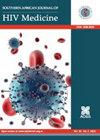骨髓检查在传染病病房的诊断价值
IF 1.6
4区 医学
Q4 INFECTIOUS DISEASES
引用次数: 6
摘要
背景:晚期人类免疫缺陷病毒患者常表现为不明原因的发热或细胞减少。骨髓抽吸和环钻检查是一种侵入性的手段,以帮助诊断谁目前的诊断困境的病人。目的回顾性分析南非传染病病房骨髓检查的诊断价值。方法回顾2012年1月1日至2014年12月31日在南非约翰内斯堡Charlotte Maxeke约翰内斯堡学术医院传染病病房进行骨髓检查的患者的记录。一个独特的诊断被认为是任何诊断的骨髓检查单独,或诊断更及时的骨髓检查比其他调查。结果327例患者行骨髓检查,其中77例(23.5%)有80例异型诊断。独特的诊断包括肉芽肿(n = 49)、结核分枝杆菌(n = 17)、鸟分枝杆菌复体(n = 3)、血液恶性肿瘤(n = 4)和纯红细胞发育不全(n = 5)。白细胞计数≤4 × 109/L预测独特的结果(p < 0.01)。白细胞计数≤4 × 109/L、CD4细胞计数≤50 cells/mm3预测骨髓分枝杆菌感染。结论:23.5%的骨髓检查的独特诊断结果表明,这仍然是一种有用的调查方式,在那些较少侵入性检查没有产生诊断的患者。本文章由计算机程序翻译,如有差异,请以英文原文为准。
The diagnostic utility of bone marrow examination in an infectious disease ward
Background Patients with advanced human immunodeficiency virus often present with unexplained fevers or cytopenias. Bone marrow aspirate and trephine examinations are an invasive means to aid diagnoses in patients who present with diagnostic dilemmas. Objectives A retrospective record review to assess the diagnostic utility of bone marrow examinations in a South African Infectious Diseases ward. Methods The records of patients who had undergone a bone marrow examination in the Infectious Disease ward at the Charlotte Maxeke Johannesburg Academic Hospital, Johannesburg, South Africa, between 01 January 2012 and 31 December 2014 were reviewed. A unique diagnosis was considered to be any diagnosis made on bone marrow examination alone, or a diagnosis made more timeously on bone marrow examination than with alternative investigations. Results Of 327 patients who underwent bone marrow examination, 80 unique diagnoses were obtained in 77 cases (23.5%). The unique diagnoses included the presence of granuloma (n = 49), Mycobacterium tuberculosis (n = 17), Mycobacterium avium complex (n = 3), haematological malignancy (n = 4) and pure red cell aplasia (n = 5). A white cell count ≤ 4 × 109/L predicted a unique outcome (p < 0.01). A white cell count ≤ 4 × 109/L and CD4 cell count ≤ 50 cells/mm3 predicted mycobacterial infection of the bone marrow. Conclusions The findings of a unique diagnosis in 23.5% of bone marrow examinations performed suggests that this remains a useful investigative modality in patients in whom less invasive investigations have not yielded a diagnosis.
求助全文
通过发布文献求助,成功后即可免费获取论文全文。
去求助
来源期刊
CiteScore
2.80
自引率
11.80%
发文量
41
审稿时长
>12 weeks
期刊介绍:
The Southern African Journal of HIV Medicine is focused on HIV/AIDS treatment, prevention and related topics relevant to clinical and public health practice. The purpose of the journal is to disseminate original research results and to support high-level learning related to HIV Medicine. It publishes original research articles, editorials, case reports/case series, reviews of state-of-the-art clinical practice, and correspondence.

 求助内容:
求助内容: 应助结果提醒方式:
应助结果提醒方式:


